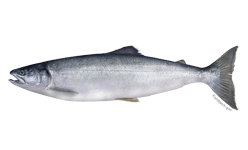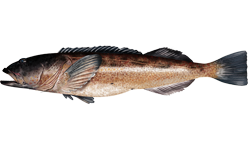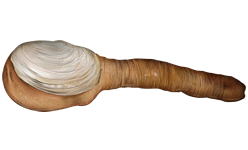Species
Salmon
There are five species of Pacific salmon that inhabit the waters of the Pacific Northwest.
 Chinook: The biggest of the five species is the Chinook, or King salmon, which in Canada are also called Springs, Tyees (when over 30lbs), and Smileys (when over 20lbs). Normal migrating Chinook spend from three to seven years in the sea before returning to their native river to spawn. Chinook have been reported to grow as big as 100lbs, but the majority of returning fish are under 30lb. Returning migratory Chinook are normally caught close to structure, that is, underwater ledges, shelves and pockets that hold baitfish. If you start fishing before light, you can fish near the surface, but as soon as the sun hits the water, you’ll want to start presenting your lures deeper if you’re targeting Chinook. Some hatchery-raised Chinook are purposely kept in net pens and delayed-released into the saltwater. These fish never migrate far out to sea, but stay resident to coastal waters. These are the fish we fish for in the winter, and these are called blackmouth. Blackmouth are normally from five to 15lbs, and a 20lb’er is a trophy. Blackmouth are normally found right on the bottom, (within 10-15 feet of the bottom), at around the 120 foot depth.
Chinook: The biggest of the five species is the Chinook, or King salmon, which in Canada are also called Springs, Tyees (when over 30lbs), and Smileys (when over 20lbs). Normal migrating Chinook spend from three to seven years in the sea before returning to their native river to spawn. Chinook have been reported to grow as big as 100lbs, but the majority of returning fish are under 30lb. Returning migratory Chinook are normally caught close to structure, that is, underwater ledges, shelves and pockets that hold baitfish. If you start fishing before light, you can fish near the surface, but as soon as the sun hits the water, you’ll want to start presenting your lures deeper if you’re targeting Chinook. Some hatchery-raised Chinook are purposely kept in net pens and delayed-released into the saltwater. These fish never migrate far out to sea, but stay resident to coastal waters. These are the fish we fish for in the winter, and these are called blackmouth. Blackmouth are normally from five to 15lbs, and a 20lb’er is a trophy. Blackmouth are normally found right on the bottom, (within 10-15 feet of the bottom), at around the 120 foot depth.
 Coho: The Coho or Silver salmon look similar to Chinook, except they are normally smaller. An important distinction is that Coho have white gums at the base of their teeth, while a Chinook’s gums are black. Coho usually live about three years, and grow exceptionally fast in the third year. They generally range in size from four to about 20lbs. Returning coho are not as structure-oriented as Chinook, and are normally found in more open water than Chinook. Coho are caught primarily in the top 50 feet of water, and close to the edges of tide rips. If you find bait on the edges of tide rips, and troll a lure near the surface, you will catch coho.
Coho: The Coho or Silver salmon look similar to Chinook, except they are normally smaller. An important distinction is that Coho have white gums at the base of their teeth, while a Chinook’s gums are black. Coho usually live about three years, and grow exceptionally fast in the third year. They generally range in size from four to about 20lbs. Returning coho are not as structure-oriented as Chinook, and are normally found in more open water than Chinook. Coho are caught primarily in the top 50 feet of water, and close to the edges of tide rips. If you find bait on the edges of tide rips, and troll a lure near the surface, you will catch coho.
 Sockeye: Sockeye salmon normally live about four or five years. Sockeye are also called Red salmon. They are usually between 4 to 7 pounds, but can grow bigger. Sockeye normally only come from river systems that have freshwater lakes as part of the system. The Lake Washington sockeye run is a good example of this. Many anglers will tell you that it’s hard to hook sockeye in salt water and impossible to hook them in the fresh water, but we’ll show you that this just isn’t true … you can have great success catching sockeye, and they are, in some opinions, the best tasting salmon.
Sockeye: Sockeye salmon normally live about four or five years. Sockeye are also called Red salmon. They are usually between 4 to 7 pounds, but can grow bigger. Sockeye normally only come from river systems that have freshwater lakes as part of the system. The Lake Washington sockeye run is a good example of this. Many anglers will tell you that it’s hard to hook sockeye in salt water and impossible to hook them in the fresh water, but we’ll show you that this just isn’t true … you can have great success catching sockeye, and they are, in some opinions, the best tasting salmon.
 Pink: Pink salmon are also known as Humpies. Pinks only live two years, and are about 4-6 pounds, sometimes larger. Pinks In Puget Sound, the majority of the pink runs happen every other year on the odd-numbered years. When the humpies are in, they are easy to catch. They also taste good, but it’s important to clean them immediately and care for them correctly.
Pink: Pink salmon are also known as Humpies. Pinks only live two years, and are about 4-6 pounds, sometimes larger. Pinks In Puget Sound, the majority of the pink runs happen every other year on the odd-numbered years. When the humpies are in, they are easy to catch. They also taste good, but it’s important to clean them immediately and care for them correctly.
 Chum: Chum salmon are also known as Dog or Keta salmon. Chum salmon live three to five years, and are normally 10 to 15 pounds, sometimes larger. In most Puget Sound waters, the chums are the last fish to return to the rivers to spawn.
Chum: Chum salmon are also known as Dog or Keta salmon. Chum salmon live three to five years, and are normally 10 to 15 pounds, sometimes larger. In most Puget Sound waters, the chums are the last fish to return to the rivers to spawn.
Halibut
 Halibut are a strange fish. They spend the larval part of their lives swimming upright, with eyes on both sides of their head, but soon one of their eyes migrates to the other side of their body, and they live the rest of their life as a flatfish, staying at or near the bottom most of the time. Halibut feed on all kinds of food, from fish to crab, to other halibut.
Halibut are a strange fish. They spend the larval part of their lives swimming upright, with eyes on both sides of their head, but soon one of their eyes migrates to the other side of their body, and they live the rest of their life as a flatfish, staying at or near the bottom most of the time. Halibut feed on all kinds of food, from fish to crab, to other halibut.
Lingcod
 Lingcod is neither a ling nor a cod – it’s a member of the Pacific greenling family, Hexagrammidae, native only to North Pacific waters off the west coast of North America. These have to be one of the meanest, ugliest fish down in the depths of the salt, but they’re also a good battle and the thought of the razor sharp teeth coming up at you gets your blood pumping for more.
Lingcod is neither a ling nor a cod – it’s a member of the Pacific greenling family, Hexagrammidae, native only to North Pacific waters off the west coast of North America. These have to be one of the meanest, ugliest fish down in the depths of the salt, but they’re also a good battle and the thought of the razor sharp teeth coming up at you gets your blood pumping for more.
Puget Sound versus Ocean lingcod: First of all, we have to distinguish between lingcod in Puget Sound versus lingcod in the Pacific Ocean. Yes they are the same species, but we have different methods for catching each, and the biggest difference is size. In the Puget Sound, find a sunken ship, sunken bridge (i.e. Tacoma Narrows), or just about any breaker wall or reef made out of boulders and you’ve already found the habitat for Lings. Many of the marinas are popular spots for Ling fishing as the huge boulders put in place to protect the marina also is where they will burrow down and seek protection themselves. They like “holes” in the rocks like a cave, that allow them to view non-suspecting prey and then devour them.
Generally when fishing for Lings out in the open ocean, we are in fact targeting Halibut. Out in 500 – 800ft of water one thing is for sure: we’re using something heavy. The 35oz Norwegian Jig will not only get you to the bottom fast, but the Lings absolutely love these things. Halibut will also jump on them so if you’re specifically trying for Lings, “jig” more frequently instead of just leaving it on the bottom. The more action the jig has the more likely you are to hook a Ling than a halibut. Another method is a plain old pipe jig. Same as with the Norwegian jig, more movement will entice a Ling. As for tackle recommendations, for deep ocean fishing we’re using strictly Halibut gear. A nice stout 5′ rod rated up to 150lbs, and 400 yards of 80lb Power Pro on a Penn Senator 114H Reel with power handle works very nicely.
Clams
 Geoduck: The name geoduck (“gooey-duck”) comes from a Nisqually word meaning “dig deep.” Found in Washington, British Columbia, and Alaska, geoducks are the world’s largest burrowing clam species, growing up to 36-inches in length. Due to their immense size, they cannot fit inside their shell like other clams. Geoducks burrow deep in the sediment, so harvesting them is a difficult, but fun, task. About 90-percent of geoduck exports from Washington state go to China, where the clam is considered a delicacy.
Geoduck: The name geoduck (“gooey-duck”) comes from a Nisqually word meaning “dig deep.” Found in Washington, British Columbia, and Alaska, geoducks are the world’s largest burrowing clam species, growing up to 36-inches in length. Due to their immense size, they cannot fit inside their shell like other clams. Geoducks burrow deep in the sediment, so harvesting them is a difficult, but fun, task. About 90-percent of geoduck exports from Washington state go to China, where the clam is considered a delicacy.





